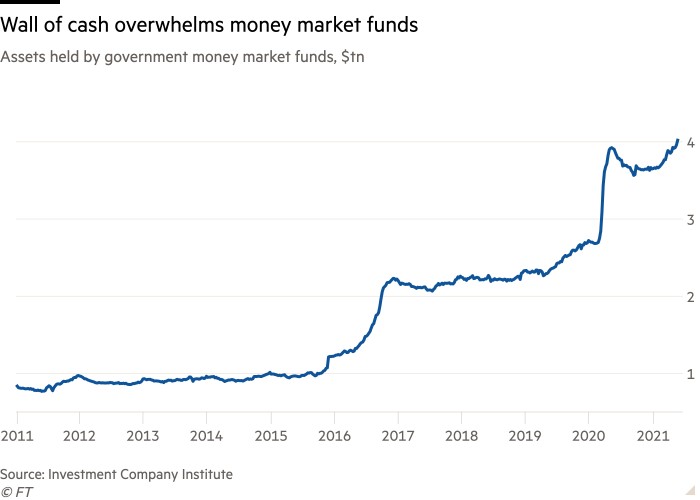A sector of the US finance industry that looks after $4tn of savings for individuals and businesses has come under severe strain as US markets flirt with negative interest rates.
Money market funds investing in short-term government debt have taken in hundreds of billions of dollars of new money from savers in recent months. But there is stiff competition to tap a dwindling supply of low-risk assets that generate positive returns.
The result has been a squeeze that has driven the yields on some debt below zero, rendering swaths of the industry unprofitable and setting up a challenge for the Federal Reserve, which analysts say may have to weigh in to keep US interest rates positive.
If government money market funds have to keep investing at zero per cent, the economics of the industry “breaks down”, said Christopher Tufts, global head of portfolio management for JPMorgan Asset Management’s money market business. “I wouldn’t be surprised if funds start to limit investor subscriptions or close outright to new [money].”
“It’s definitely not a pleasant place to operate at this red-hot moment in time,” said Deborah Cunningham, chief investment officer of global liquidity markets at Federated Hermes, one of the world’s largest money market fund managers. “There’s really not much value anywhere.”

The downward drift in short-term interest rates has grown more acute in recent weeks as more cash has flowed into the financial system.
A steady drip has come from the Fed, which is buying $120bn of Treasuries and agency mortgage-backed securities each month. The Treasury department has compounded the situation by doling out funds associated with the Biden administration’s stimulus package passed in March.
At the same time, the Treasury has also been shrinking the stock of short-term bills in circulation as part of its efforts to lengthen the maturity of the government’s outstanding debt.
In some cases, investors have effectively had to pay for the privilege of lending to the US government, since Treasury bills maturing within one month recently yielded below zero. The rate at which investors swap Treasuries and other high-quality collateral for cash in the repo market, another staple source of income for money market funds, has also turned negative at times.
Peter Crane, publisher of Crane Data, estimated the average seven-day yield for top-tier government money market funds now hovers around 0.02 per cent, well below the 1.39 per cent level seen at the end of 2019. Most money market funds have waived fees for investors, given that they would eat up the yield on offer.
Despite the meagre returns, government money market fund assets swelled above $4tn for the first time in the week ending May 26, according to data from the Investment Company Institute.
Some of these inflows stem from the banks which have been urging large corporate clients to direct cash into money market funds rather than deposit it in their accounts. US bank executives say they are struggling to use the cash piling up in deposit accounts, which triggers stringent capital requirements they would rather avoid.

Money market fund managers with few good investment options have increasingly been turning to the Fed, which offers select banks and investment groups a place to stash cash overnight through its reverse repo programme (RRP) facility at an interest rate of zero per cent.
A record $485.3bn was steered there last week, earning nothing, and according to Doug Spratley, head of the cash management team at T Rowe Price, it has become “crucial” for the industry.
“If we need collateral for the day, and we are getting negative rates from the street or zero rates even from the street, we will go to the Fed and consider it to be the right trade for the day,” said Federated Hermes’s Cunningham. “When others get to the more expensive pricing, the Fed at zero has value.”
The Fed itself faces pressure to intervene in short-term markets. Its benchmark rate, the federal funds rate, has fallen along with other short-term rates and now sits well below the middle of the zero per cent to 0.25 per cent target range. It recently slipped by 0.01 percentage point to 0.05 per cent, according to the New York branch of the central bank, a level many rates strategists believe could compel the Fed to act.
Richard Mejzak, head of global portfolio management for BlackRock’s cash management group, expects an increase in both the RRP rate and the interest the Fed pays banks on reserves they hold at the central bank — perhaps as soon as the next monetary policy meeting this month.
Without some relief, the “longevity” of the money fund industry could be at risk, warns Mark Cabana, a rates strategist at Bank of America.
“Money funds have already waived fees, and they are earning virtually zero,” he said. “There are questions about how long money funds can remain viable as lossmaking entities.”
Unhedged — Markets, finance and strong opinion
Robert Armstrong dissects the most important market trends and discusses how Wall Street’s best minds respond to them. Sign up here to get the newsletter sent straight to your inbox every weekday

